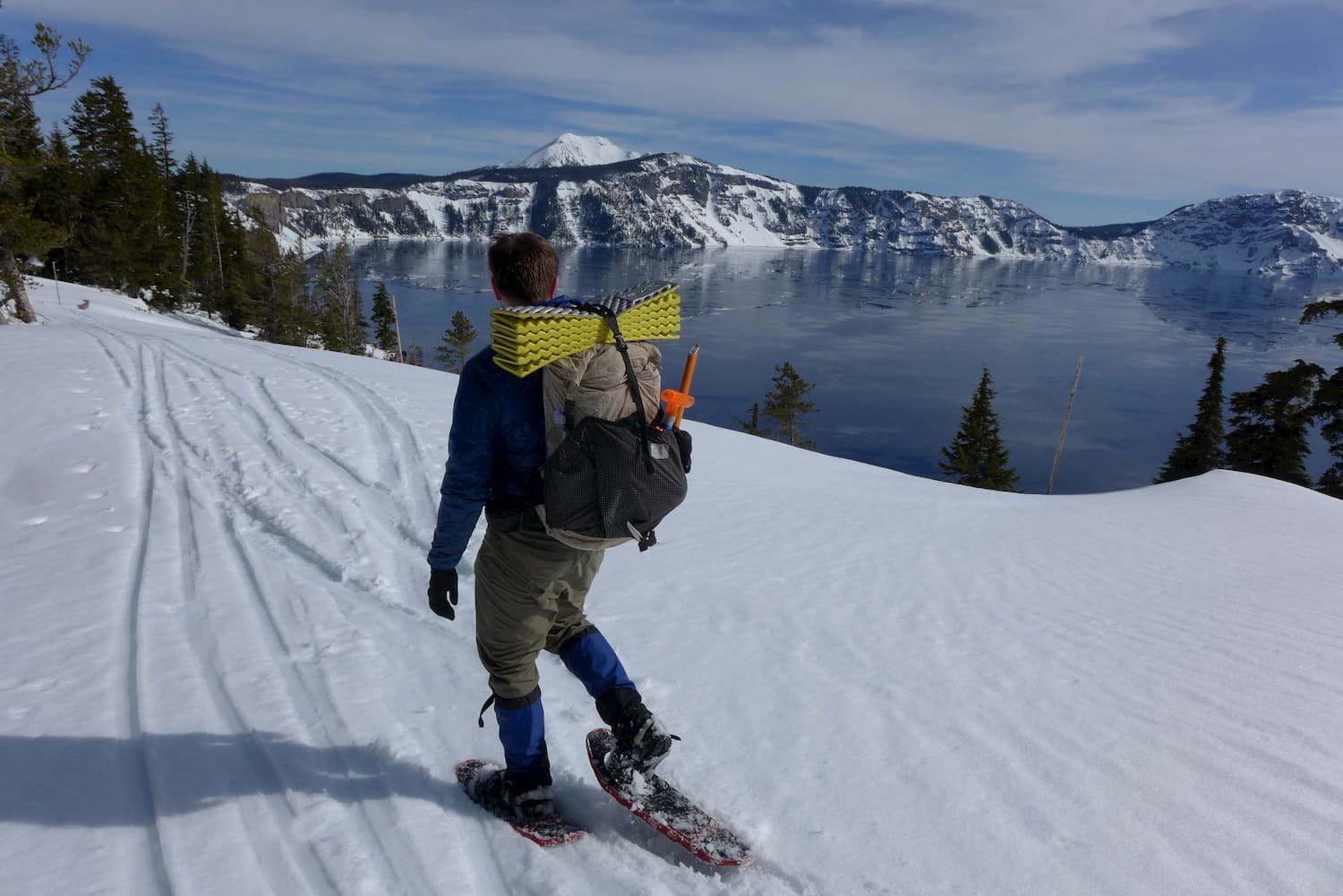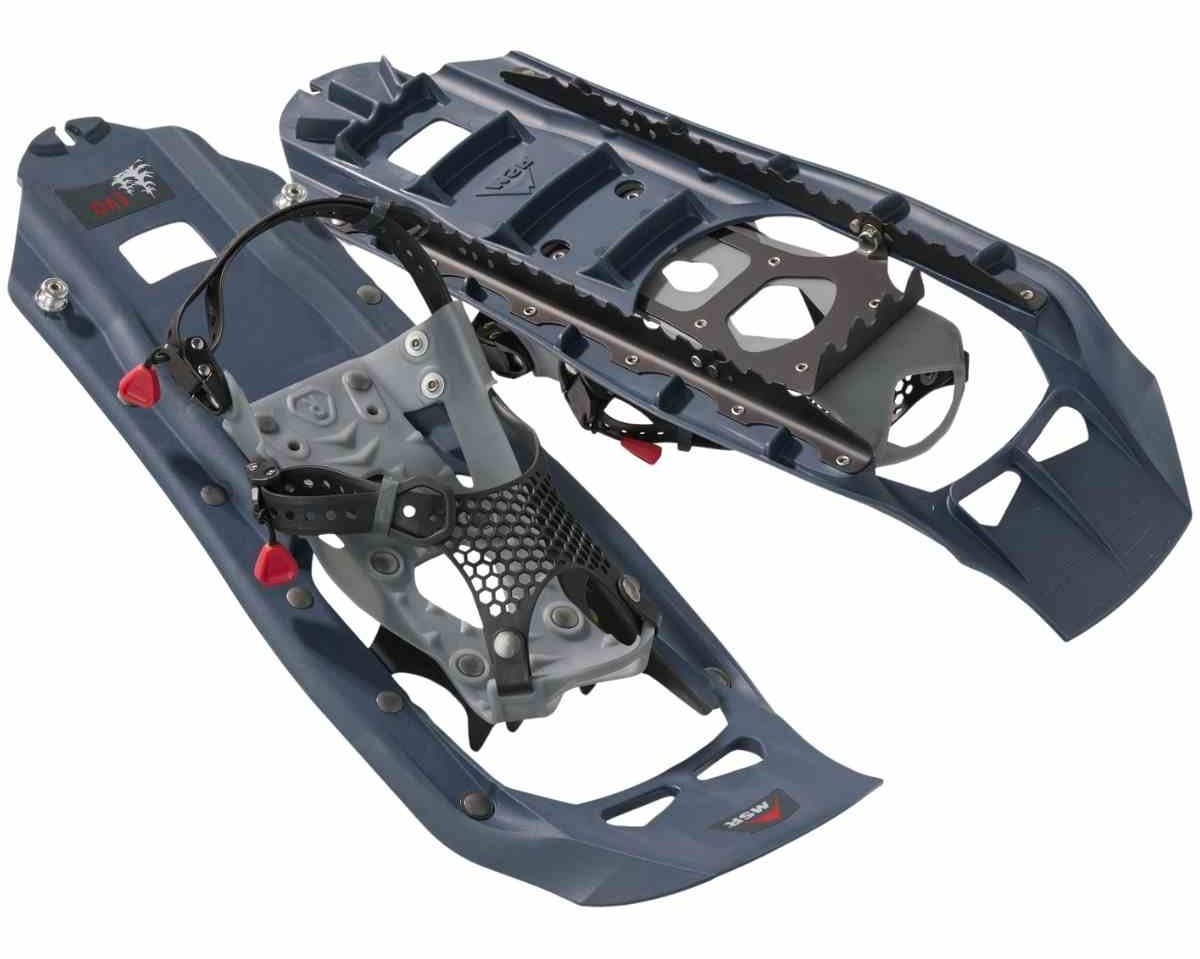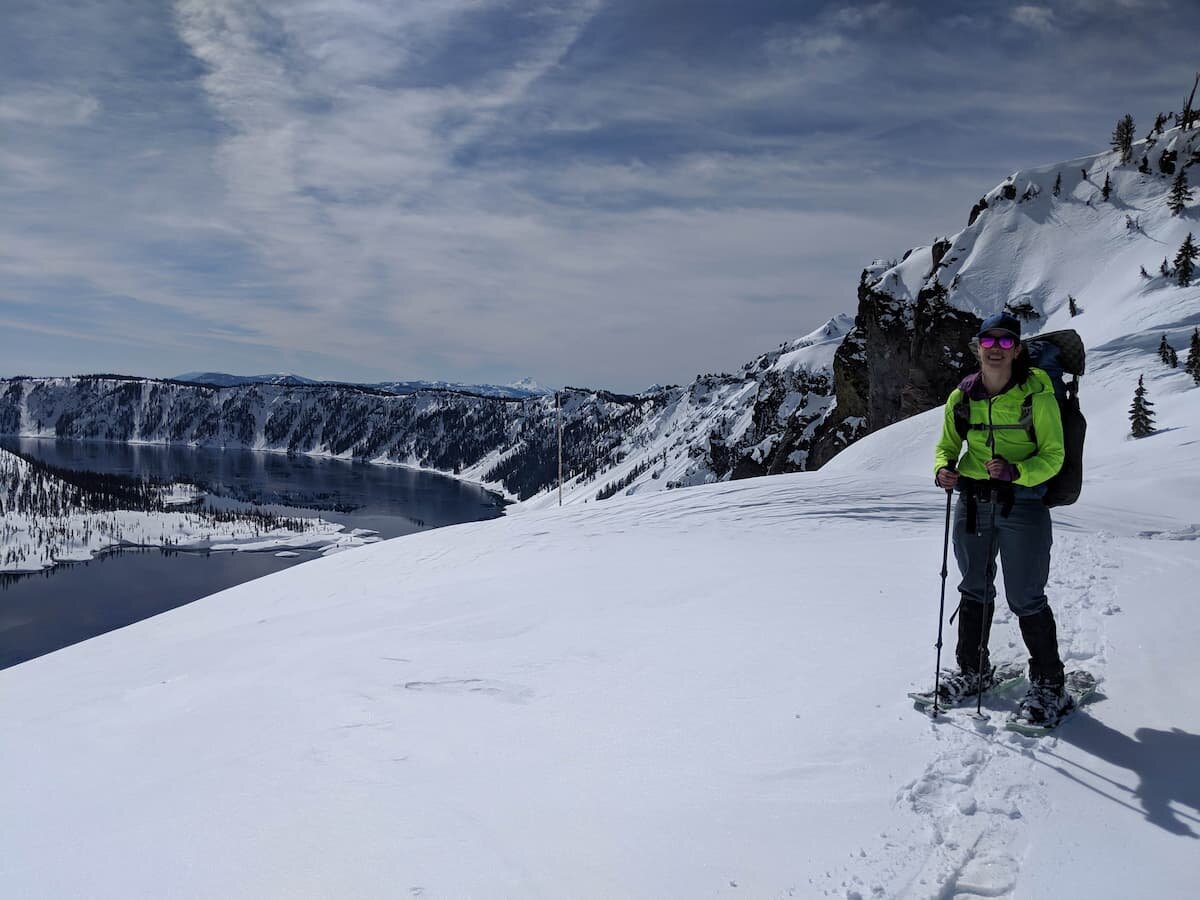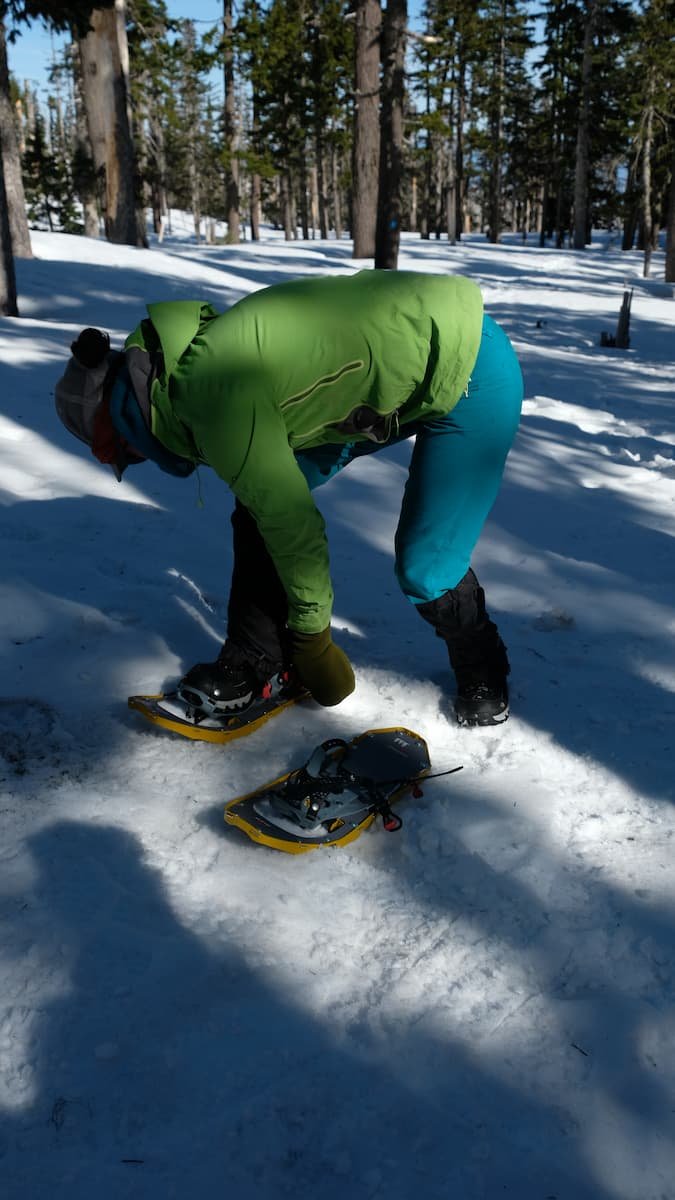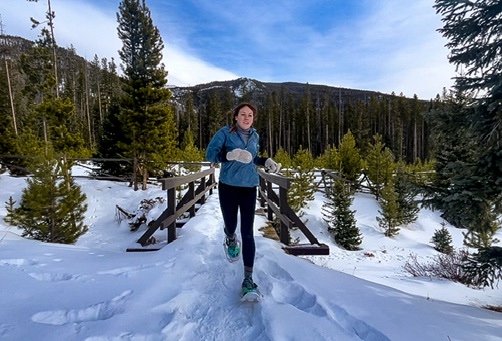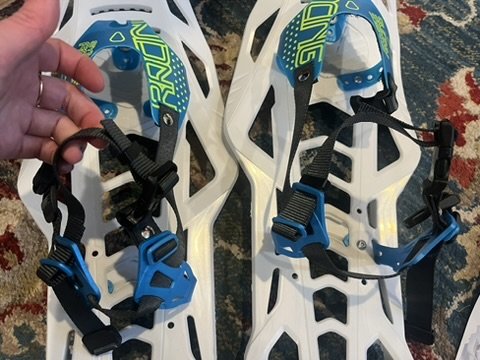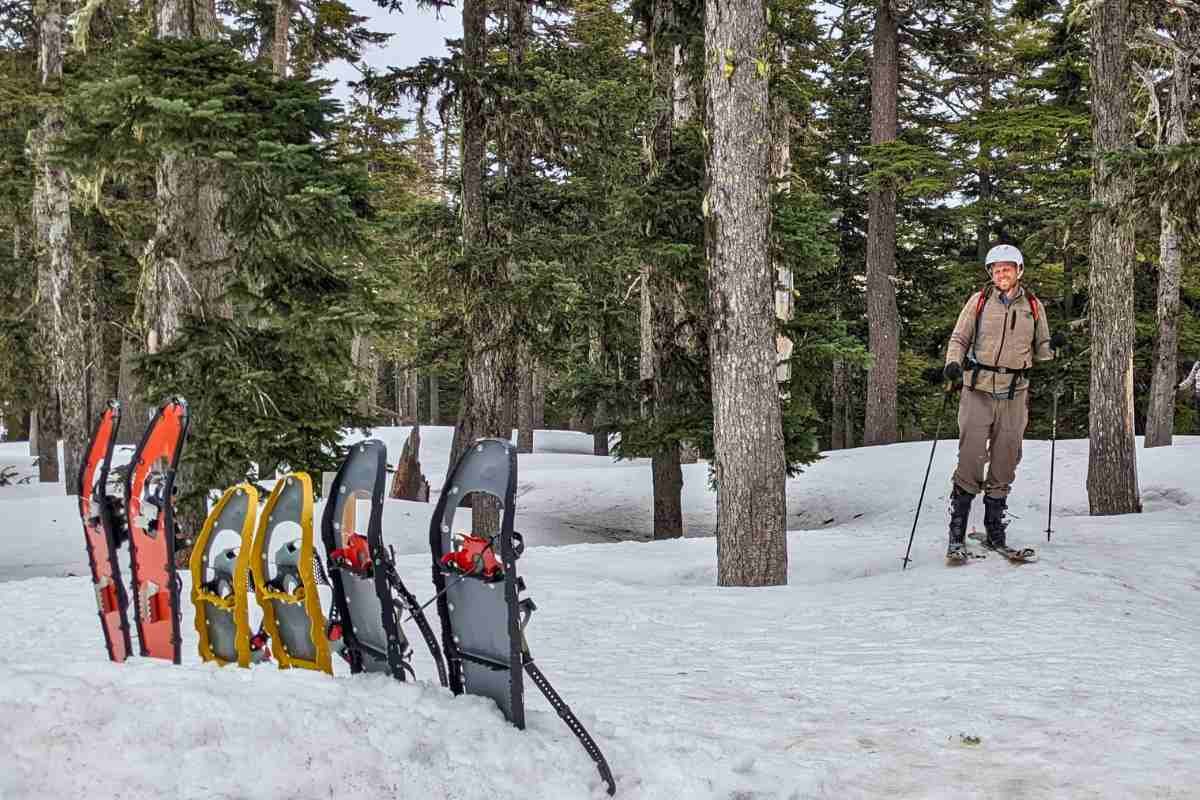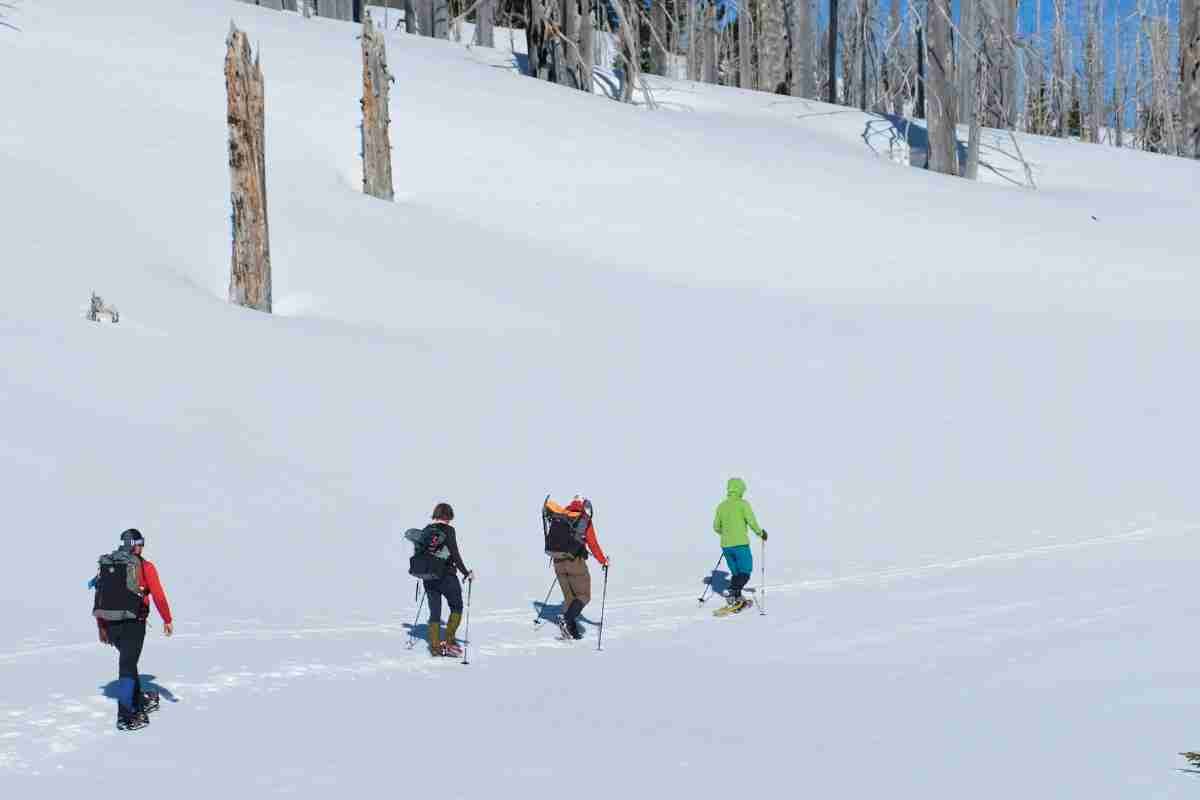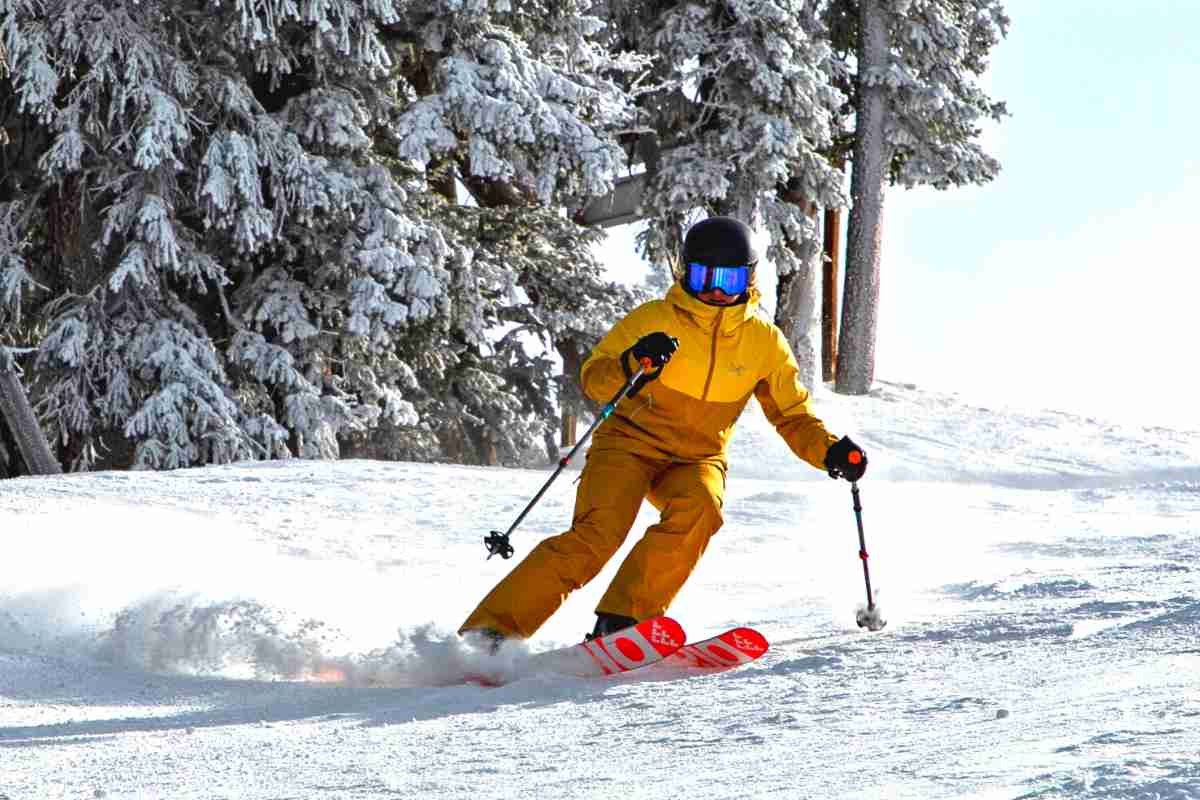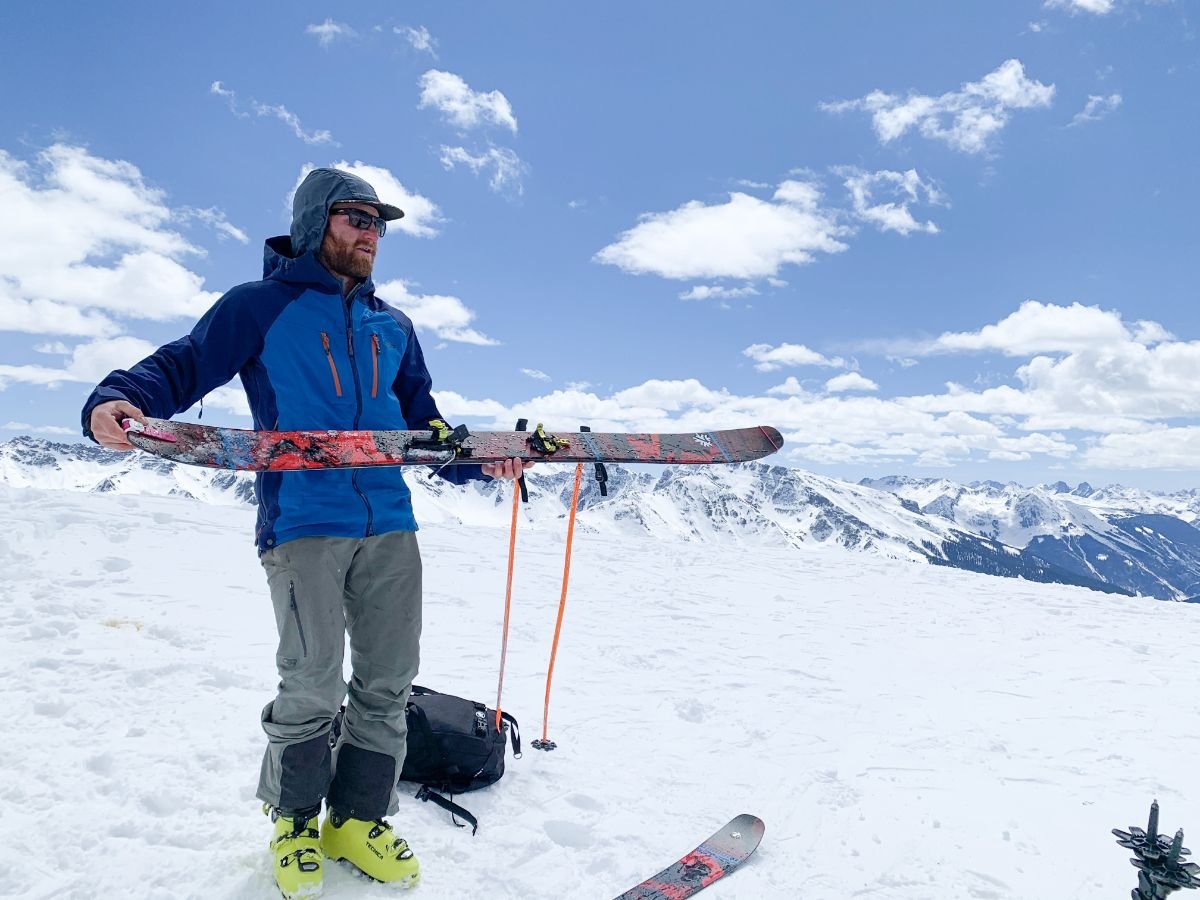Best Snowshoes of 2025
Top Rated Snowshoes For Winter Hiking, Running, And Snow Sports
Last updated December 17th, 2024 with design updates to several models by MSR and a new snowshoe tested
We've tested more than a dozen snowshoes over almost 5 years to find the best snowshoes for all levels of winter hikers, runners, and mountain climbing.
I’m a Colorado-based writer for Snowshoe Magazine. I’ve snowshoed for assignments covering America’s top Nordic centers, profiled snowshoe trails for day trips, hauled gear for overnight yurt trips, and experienced first-hand the pros and cons of snowshoe gear—the good, the bad, and the ugly.
To find the best snowshoes, we combed through hundreds of outdoor media and customer reviews and interviewed industry experts. Then we trekked through slush and powder in over a dozen models to find the best snowshoes for most people—for beginners to seasoned backcountry adventurers and for hiking, running, and everything in between. From dry, deep snow in Colorado to wet, heavy snow in the Pacific Northwest, here are our best snowshoes of 2025 for all kinds of snowshoers.
Looking to plan your first snowshoe excursion? Check out our guide on How to Prepare for a Snowshoe Trip.
We write mission-driven gear reviews. To find the best gear, we combine expert reviews, everyday user opinions, and rigorous independent trail testing—never pop-up or display ads. We are reader-supported and may make a small commission from some qualifying affiliate links. Learn more.
Snowshoe Comparison Table
| SNOWSHOE | TREELINE AWARD | MSRP* | RECOMMENDED USE | WEIGHT | SIZES / LENGTHS | BINDING TYPE | FRAME / DECK MATERIAL | HEEL LIFT? | MAX LOAD |
|---|---|---|---|---|---|---|---|---|---|
| MSR Evo Trail | Best Overall Read why |
$170 | Trail | 3 lbs. 9.5 oz. | 22" only | Rubber Dual Strap | Polypropylene plastic (one piece) | No | 180 lbs/250 lbs with tails |
| MSR Lightning Ascent - Men's | Best Backcountry - Men's Read why |
$390 | Backcountry | 4 lbs. 5 oz. (25 in.) | 22", 25", and 30" | Paragon bindings (mesh straps) | Aluminum/TPU Coated Nylon | Yes | 280 lbs/300+ lbs with tails |
| MSR Lighting Ascent - Women's | Best Backcountry - Women's Read why |
$390 | Backcountry | 3 lbs 14 oz (25 in.) | 22" and 25" | Paragon bindings (mesh straps) | Aluminum/TPU Coated Nylon | Yes | 210 lbs/270 lbs with tails |
| Crescent Moon EVA | Best for Casual Hiking Read why |
$170 | Trail | 3 lb. 5 oz. | 24" | Pull webbing (like velcro) | Dual-density EVA foam for both - sustainable, recyclable and heat-insulating | No | 200 lb |
| Atlas Helium Backcountry | Best for Thru-hiking Read why |
$210 | Backcountry | 3 lbs 2 oz (23 in) | 23" and 26" | Pack flat single urethane z-trail | Aluminum/Composite | Yes | 220 lbs |
| Atlas Helium Mountain | Best for Thru-hiking Read why |
$230 | Backcountry | 3 lb 5.6 oz (26 in) | 23" and 26"and 30" | BOA Binding | Aluminum/Composite | Yes | 220 lbs |
| Tubbs Mountaineer - Men's | Best for Big People and Heavy Loads Read why |
$280 | Backcountry | 4 lbs 14.4 oz (25") | 25", 30", 36" | Ratchet strap | Aluminum/Nytex Nylon | Yes | 300 lbs |
| Tubbs Mountaineer - Women's | Best for Big People and Heavy Loads Read why |
$280 | Backcountry | 4 lbs 4.8 oz | 21", 25" | Ratchet strap | Aluminum/Nytex Nylon | Yes | 200 lbs |
| TSL Outdoors Symbioz HyperFlex Racing Snowshoe | Best for Running Read why |
$200 | running/racing | 1 lb 6.4 oz | 21.1" | Composite | 220 lbs |
* Prices reflect MSRP and are subject to change. We note any discounts we see on our Deals page, which is updated daily.
The Best Snowshoes
Best Overall Snowshoes: MSR Evo Trail
Recommended use: Trail
Weight: 3 lbs 9 oz
Size/Lengths: 22” only
Binding: Rubber Dual Strap
Frame: Polypropylene plastic (one piece)
Weight limit: 180lbs/250 lbs with tails
What we liked: Excellent value, easy to use with gloved hands, durable
What we didn't like: Not enough floatation for some, but optional tail available
The MSR Evo Trail is also a best-seller on Evo, Amazon, and Backcountry with customers raving about the excellent traction, durability, and easy-to-use bindings. This is a great set of recreational snowshoes for most people sticking to rolling terrain.
The new Paraglide™ bindings are a huge improvement to the old style from a usability and comfort standpoint. They're much easier to put on and get a good fit that stays in place and feels comfortable. I had always had problems with getting the right tension on the old style binding– too tight and it would cut in and hurt my foot or cause me to lose circulation, too loose and the snowshoe wouldn’t stay on my foot!
I've mainly used the trail series for snowshoeing into foot-only access winter cabins and hut trips. They lack the heel risers of some of the higher end models, but unless you're doing a lot of steep climbing, those won't be missed.
MSR EVO snowshoes (unisex)
The MSR Evo Snowshoes are a good balance of price, durability, and quality construction and are suited for beginner snowshoers or more advanced users who don’t need aggressive features.
Features
A few notable features on the MSR Evo include one of the best features found in pricier models of MSR snowshoes: MSR’s one-piece “Unibody” plastic construction eliminates the traditional tubular frame. The result is that the Evos are one of the lightest pairs of snowshoes we considered.
The steel crampon under the pivoting toe plate and along the outside rails of each shoe is high quality and durable, helping these shoes to last a long time, further adding to the good value.
The rubber “pinhole” style binding straps are freeze-proof and easy to fasten, even with gloves.
Beginner-Friendly
For basic snowshoeing, there aren’t a lot of things to dislike about the MSR Evo’s simple design. With the previous model, some users complained that these snowshoes have “floppy straps.” While we actually found its floppy bindings straps to be a plus, the updated Paraglide™ bindings–which launched last Fall–should alleviate this problem for folks. These bindings use two roller buckles and toe stops to make securing and removing your feet more intuitive.
If you are a beginner, we highly recommend preparing thoroughly for your first snowshoeing trip.
On harder pack snow in the Pacific Northwest wearing the MSR Evo Trail snowshoes, we didn’t have trouble with float, even when carrying a heavy fully-loaded backpack.
Weight limit
Some users found that it doesn’t have enough float in deep powder. Although this model doesn’t include a heel lift, you can purchase six-inch snap-on powder tails (or modular flotation tail) to provide additional float (this is partially what keeps the price low-sort of like an a la carte snowshoe.) So if you’re carrying a heavy pack or anticipate deep powdery snow, the tails are a great option to carry with you. Another option is if you'd normally go with a women's snowshoe, to instead choose a men's snowshoe, which is typically designed for more float.
The manufacturer claims that the Evo without the tail will support up to 180 pounds. Some customer reviews suggest a maximum capacity of just 150 pounds, although this could be due to the type of snowpack they were trying to use them in.
For example, if you weigh more than 150 pounds, we suggest adding optional tails to extend the float in deep powder. With the flotation tails, MSR says the maximum load is 250 pounds. Remember that the weight limits include your body weight plus your gear—worn clothing, water, food, backpack, and contents.
And while we’re on the subject of clothing, remember to include winter gloves and quality base layers to your wardrobe for winter adventures.
You can learn more about MSR's snowshoe sizing system here.
Other versions
The Evo has become such a trusted name that MSR launched a more technical version, the MSR Evo Ascent (see our review below). Ultimately, we think the MSR Evo Trail is a better deal than the Ascent. For the same price as the Evo Ascent, you can get the Evo Trail Snowshoe Kit, which includes the Evo Snowshoes, a pair of lightweight adjustable aluminum Dynalock Trail Poles, and an MSR backpack with a removable foam seat, hydration compatibility, and loops to attach poles.
If you want to venture into the backcountry, we think you’d be better served by our Best Snowshoe for the Backcountry winner, the MSR Lightning Ascent (see full review below). The reason? The Lightning Ascent is better suited for technical terrain and can handle more weight for you to carry more gear.
Best Backcountry Snowshoe: MSR Lightning Ascent Snowshoe
The MSR Lightning Ascent is a gold-standard snowshoe that got a recent update with new Paragon bindings that are more secure, comfortable, and easier to use.
Recommended Use: Backcountry
Weight: 4 lbs. 5 oz. (25 in.)
Sizes/Lengths: 22", 25", and 30"
Binding type: Paragon bindings (mesh straps)
Frame/Deck material: Aluminum/TPU Coated Nylon
Weight Limit: 280 pounds (30”)/300+ pounds (with tails)
What we liked: Steel and aluminum construction, traction excels in backcountry settings. Heel lift aids climbing steep terrain
What we didn't like: A little pricey
The men’s and women’s MSR Lightning Ascent snowshoe appear on almost every review site and snowshoe gear article we saw–including “Best Snowshoe Overall” by REI Journal.
Despite being one of the most expensive pairs on the market, these mountain snowshoes simply couldn’t be ignored. Updates to the model make this our favorite technical lifetime snowshoes, made even better with a more comfortable and intuitive binding.
Treeline Review writers and testers have taken the Lightning Ascent snowshoes on everything from circumnavigations of Crater Lake National Park to hundreds of miles on snowy thru-hikes of the Continental Divide Trail. These win our award for their ability to handle steeper, rougher, and icier terrain and remain durable and have the traction you need. If you only own one pair of snowshoes to do everything, these are the pair to get.
MSR Lightning Ascent Snowshoes
Women's
Men's
Durability in the backcountry
The MSR Lightning Ascent has multiple sizes for both men and women. Photo by Kate Hoch
The MSR Lightning Ascent excels in backcountry conditions over the otherwise great MSR Evo Trail (our overall winner; see full review above) because of increased traction and durability. The MSR Lightning Ascent is made of aluminum and steel instead of plastic.
The Lighting Ascent also has a backcountry essential: heel lifts, which MSR calls the “Ergo Televator.” This heel lift system makes it more comfortable to snowshoe up steep ascents and in the backcountry. In flat conditions, you won’t use the Televators. But when climbing, on the Lighting Ascent you can activate the Ergo Televator using your trekking poles, so you don’t have to squat down (check out our Best Trekking Poles guide or Best Ski Poles guides for recommendations). Although they're designed as mountaineering snowshoes, the Lightning Ascent is also designed so that you can walk with a more natural stride, so the Lightning Ascent feels more comfortable on longer and more technical hikes.
Long-term versatility
We consider this a “lifetime” snowshoe because although it can be used on flat/firm surfaces for beginners, it also can take you into the steeps and deeps with no problem if you chose to go there someday. The steel crampon is incredibly durable. These also have the option for the additional MSR Lightning Ascent powder tails (or flotation tails), for deep snow. The flotation tails have a simple attachment system such that you can add or remove them without removing your snowshoes.
Treeline writer Kate Hoch testing the Lightning Ascent snowshoes at Crater Lake. Photo courtesy Kate Hoch.
Almost all Treeline Review staff have purchased and owned the Lightning Ascent snowshoes over the years. While we don’t all have the same models, we’ve found that they last many winter seasons. Editor Naomi Hudetz says she likes the Lightning Ascent over other snowshoes because “the bindings are intuitive, secure, and easy to handle.” Hudetz especially noted that she likes that “women’s are narrow enough for me that I don’t feel like I have to adjust my gait to avoid hitting my legs or feet with the snowshoes.”
MSR lightning ascent sizing
The new bindings on the MSR Lightning Ascent women’s snowshoes are much easier to get on and off, which is ideal for situations with mixed snow conditions.
The women’s are sized as follows:
22 inch - up to 180 pounds/ 240 pounds with tails
25 inch - up to 210 pounds/ 270 pounds with tails
The men’s version has 3 sizes:
22 inch - up to 180 pounds/ 250 pounds with tails
25 inch - up to 220 pounds/ 280 pounds with tails
30 inch - up to 280 pounds/ 300+ pounds with tails
You can learn more about MSR’s snowshoe sizing system here.
The “women's version” is lighter and narrower than the "men's snowshoe." We tend to find gender labeling matters less for snowshoes than weight and your gait.
In fact, we recommend the women’s snowshoes for anyone who fits within the wait limit regardless of gender because they weigh less. Folks who fit the weight limit often have a narrower gait, so they will also benefit from the women’s design.
Remember that the weight limits include your body weight plus your gear—worn clothing, water, food, backpack, and contents. Be sure to figure all that in before choosing the size.
The Lightning Ascent grips better on steeper slopes than the budget recommendation, the MSR Evo or the Crescent Moon Eva. Photo by Kate Hoch
Lightning Ascent Updates
MSR updated the Lightning Ascent to address the only complaint testers had about earlier versions of this snowshoe: the bindings. The newest version uses Paragon bindings, designed and engineered for comfort and security. The newest model is designed to be easier to put on and remove.
According to SNEWS (see Sources), the Outdoor Industry news site, “With a one-piece, mesh top strap that conforms to an impressive variety of boot styles and sizes from women's size 5 to men’s size 13, the Paragon binding offers fast, easy, and intuitive foot alignments with a glove-like fit.”
“The mesh’s variable thickness optimizes strength and flex, providing a secure fit without painful pressure points on the foot,” says SNEWS. This is important to note because painful pressure points are often cited as a common hazard of snowshoeing in general. Gear Junkie says, “Meet the world’s first single-strap mesh snowshoe binding...with an aim to provide a glove-like fit.”
Ultimately, we think that the Paragon bindings are a serious upgrade to the MSR Lightning Ascent, addressing our only real issue with these snowshoes. If you see yourself doing any backcountry snowshoeing sometime in your life and are only going to buy one pair of snowshoes, the Lighting Ascent is the way to go.
See our most popular snow gear articles in our Winter Gear Guide:
Best Snowshoes For Hiking: Crescent Moon Eva
Recommended Use: Flat to rolling terrain on packed trails
Weight: 3 lb. 8 oz.
Sizes/Lengths: 24”
Binding type: Pull webbing (like velcro)
Frame/Deck material: Dual-density EVA foam for both — sustainable, recyclable and heat-insulating
Weight Limit: 200 pounds
What we liked: No fuss, approachable design, simple to put on and remove. Comfortable for casual use and running
What we didn't like: Not the most capable in technical terrain. Optional ice cleats can take some time, but require only basic tools
The Crescent Moon Eva Foam snowshoe deserves all the praise we’ve seen it get in the outdoor space since its debut. It’s a top seller on REI and was included on Outside Magazine’s “Best Snowshoes” list. It won 7 Best of the Show outdoor gear awards at Outdoor Retailer.
Crescent Moon Eva Snowshoes (Unisex)
Rave reviews
People love this recreational snowshoe, which is fully recyclable, for its sustainable materials, springy stride, easy bindings, one-size-fits-all fit, and daily usability. These snowshoes are perfect for daily use in a wide range of weather conditions, from walking the dog and grabbing the mail to trail running and hiking in snow. They’re even great in mud since they can be easily hosed off.
Professional reviews say the Crescent Moon Eva Foam has “effortless float” (thanks to a rockered tip and tail) and “responds like an athletic shoe” (thanks to the malleable, dual-density foam deck).
Customers rave about how quiet, lightweight, flexible, fun, and easy the Eva is to use in most conditions and situations, from hiking, walking the dog, and even trail running. It has 12 durable rubber lugs and optional ice cleats for hardpack and icy conditions, though, for steep and variable terrain, we would recommend the MSR Lighting Ascent (see our full review above).
Running shoe-inspired
The Crescent Moon Eva snowshoe was inspired by the Hoka brand shoes, which has winners in our Best Hiking Shoe story, Best Trail Running Shoe story, and Best Lightweight Hiking Boot stories. These shoes are known for their rocker sole and feel like you’re “floating on clouds,” with lots of cushioning.
Crescent Moon founder Tamara Laug is a runner and liked the rocker-like shape on the Hokas while moving on dirt. The Crescent Moon Eva is designed to give a similar lightweight, quiet, and comfortable experience on snow.
Fixed binding system
Besides the curved shape of the deck that helps propel you forward (contributing to the “effortless” feel mentioned above) the main difference between the Crescent Moon Eva shoe and traditional snowshoes is the fixed binding system.
Other snowshoes feature a pivoting binding system, where the toe punches down through the deck on each step. But on the EVA your foot stays entirely on top of the foam deck surface, which some people say is genius, and others complain that this prevents a natural stride and leads to snow “shoveling” with the toe of the shoe.
During my own test of this modern style, I didn’t notice the shoveling or any discomfort with the stride on theCrescent Moon Eva. They definitely feel different than my traditional snowshoes, but in a good way.
Our testing notes
Senior editor Brandon Lampley snowshoeing with the Luna, the lighterweight version of the Eva. Photo courtesy Brandon Lampley.
Treeline Review editor Liz Thomas also tried these snowshoes and found them incredibly easy to take on and off–a factor that detracts many would-be snowshoers from getting into the sport. She reports, “It felt more like walking in a sneaker or trail runner than a traditional snowshoe. The binding system was intuitive-and that’s saying a lot coming from me.”
In my own testing in the fluffy snow outside Rocky Mountain National Park, the springy step took a little getting used to, but ultimately it felt great. I did notice some snow flipping up my back. But I was dressed in waterproof outerwear (which you should consider doing when snowshoeing), so it didn’t bother me.
I liked how quiet the Evas were, and that I could take them through muddy patches on the hiking trail without worrying about scraping heel crampons on a rock. I didn't even get my own foot muddy thanks to the full coverage deck. This feature alone makes these snowshoes well-suited for use in early winter or late spring when you’re more likely to encounter the occasional muddy patch.
The Evas are also not recommended for deep powder. We'd also recommend a dedicated running snowshoe if you're into snow racing or know that you'll be running exclusively on groomed trails.
Crescent Moon also offers the Luna Eva snowshoe, designed to be lightweight with runners and women in mind. They’re only 21” long. We tested this model and found it to have a surprising amount of float—even for our senior editor who is above the weight limit for that shoe. Still, we recommend the Eva for most folks. The Luna is appropriate for folks who plan to run.
One thing I was concerned about was the reviews saying this shoe didn’t have much traction since there are no metal cleats. But updates to the model addressed this issue by adding tiny ice spikes to the base, which provided a surprising amount of grip despite their small size. These won’t get you up Everest, but they are fine for normal to moderate conditions. The manufacturer page says they are not recommended for deep snow or steep or variable terrain—try the MSR Lightning Ascent if you expect those kinds of conditions (see our full review above).
Installing ice cleats onto the Luna. Photo by Brandon Lampley.
Our only issue was minor and it was with installing the ice cleats. The Eva and Luna (the running version) come with optional ice cleats. To install them, you need a small socket driver, which doesn’t come with the snowshoes. If you happen to find yourself in the field far from your tool kit (or don’t own sockets), it can be time-consuming to improvise with a flathead screwdriver or (even slower) a coin.
Lastly, one of the things we like the most about the Crescent Moon’s trademark Eva foam materialis that it is sustainably produced. This snowshoe can actually be recycled through any local athletic shoe recycling program.
Best Thru-Hiking Snowshoes: Atlas Helium Backcountry/Mountain
Recommended Use: Flat to rolling terrain on packed trails
Weight: 3 lbs 3 oz
Sizes/Lengths: 23" and 26"
Binding type: Pack flat single urethane z-trail
Frame/Deck material: Aluminum/Composite
Weight Limit: 200 pounds
What we liked: Lightweight overall, nest well, Boa tensioning is easy to use. A fair price compared to similar snowshoes
What we didn't like: BOA system might be difficult to repair if freezes up or breaks on a long trip
Snowshoes have been around forever, but ultralight models are relatively new. We are psyched about the new Helium Backcountry Snowshoe line from Atlas. Atlas’s foray into composite decks really delivers for super weight-conscious snow travelers, with a sub 3 lb snowshoe! Yes, that’s right–mountain and backcountry snowshoes at 3 lbs. For comparison, our Best Snowshoe for the Backcountry winner, the MSR Lightning Ascent (see full review above), weighs at its lightest 4 lbs 5 oz.
Great value for price
Most thru-hikers will lash their snowshoes to their packs, finding they carry them on their pack for as many hours as they need to use them in the high country. Yet, thru-hikers need a technical snowshoe that can handle steep and rolling terrain.
Atlas Helium Snowshoes
Backcountry
Mountain Boa
Up until now, the MSR Lightning Ascent was the most common snowshoe used by thru-hikers on the Continental Divide Trail traversing the San Juan mountains of Colorado or Pacific Crest Trail thru-hikers in the Sierra in the early season.
We think the new Helium Backcountry or Mountain has unseated the Lightning Ascent for two reasons: weight and price.
Helium Trail vs Helium Backcountry vs Helium Mountain
Helium Trail: 3 lbs 4 oz
Helium Backcountry 3 lbs 3 oz
Helium Mountain 3 lbs 5.6 oz
While the Helium Trail is price competitive with our Overall winner, the MSR Evo Trail (see full review above), we think thru-hikers will want the extra traction on the Helium Backcountry or Mountain series.
But we had a hard time deciding whether the Helium Backcountry series or Helium Mountain series would be best for a thru-hike. Both are available in 23 or 26-inch lengths. Both are lighter and less expensive than other technical snowshoes.
Ultimately, deciding between the two models depends on what your pain points are as a thru-hiker. Thru-hikers often must carry their snowshoes on their pack for miles. Weight and ease of lashing them to a pack are critical. The Helium Backcountry is the better option if these are your pain points.
But thru-hikers also find themselves in situations where they wake up after a night sleeping on the snow to then have to figure out how to get a frozen shoe into frozen bindings with chilled fingers. After an exhausting 20-mile day on the snow, having intuitive bindings that won’t feel like a 3-D puzzle may also be worth extra weight. The Helium Mountain is a better option if this is your pain point.
Factors to consider
Here’s how to choose whether the Backcountry or Mountain is better for your thru-hiking style.
Weight: The Helium BC is a few ounces lighter than the Helium Mountain version. This is largely due to the differences in binding systems. It uses a BOA binding system that is intuitive and quick to tighten. All but the most weight conscious will find the BOA system is worth the extra few ounces.
Ease of Lashing: The straps on the Backcountry’s binding system lay flat and the shoes nest together really well. The Helium Mountain doesn’t nest together as well as the Backcountry for lashing to your pack.
For most folks, the Helium Mountain version is going to give you almost all that lightweight benefit of the Helium Backcountry, but be easier to use. But the BOA bindings are comfortable and super convenient.
We’ve encountered some concerns about the BOA tensioning system when applied to winter sports regarding its potential for failure by icing up, or breaking, along with it being more difficult to repair in the field vs some more conventional systems. This seems to be rare, but is something to consider.
Best Snowshoe for Big People and Heavy Loads: Tubbs Mountaineer
Recommended Use: deep powder, steep uphills, some more technical terrain
Weight: 4lbs 4.8 oz
Sizes/Lengths: 21", 25"
Binding type: Ratchet strap
Frame/Deck material: Aluminum/Nytex Nylon
Weight Limit: 200-300lbs
What we liked: Appropriate for high overall load out
What we didn’t like: Mountaineering design focus may be too feature-rich than some prefer for many backcountry excursions
The women’s and men's Tubbs Mountaineer snowshoes are a favorite of many outdoors people--especially because they boast the highest weight limit (300 pounds) of the snowshoes we tested. They show up on Snowshoe Magazine’s list of Best Snowshoes for bigger people (but if you’re looking for a higher limit, their article has some great suggestions).
Tubbs Mountaineer
Men's
Women's
One downside with the Mountaineer is that it has many technical features many beginner snowshoes may think are overkill (and with it, a heftier price). As its name implies, it was built more for mountaineers rather than hikers. These features added to the price and weight of this model of Tubbs snowshoe (though we were impressed by the flotation it provided for heavier testers).
We think most people will be served better by our picks, but if you're looking for a snowshoe that can support a big person and/or a heavy pack, this is a good option.
Best Snowshoe for Running: TSL Outdoors Symbioz Hyperflex Racing Snowshoe
Weight: 1 lb 6.5 oz (pair)
Sizes/Lengths: 21.1 in.
Binding type: adjustable strap
Frame/Deck material: composite
Weight Limit: 220 lb
What we liked: ultralight, flexible, great for running and racing
What we didn’t like: binding works only with optional straps, which are difficult to put on
The TSL Outdoors Symbioz Hyperflex Racing Snowshoe is designed for quick movements on the snow. Folks planning to compete in snowshoe races will appreciate the lightweight, sleek design that allows for quick turnover without tripping over your own feet on the snow. Non-racers will also enjoy the ease in which they can run or even hike in the snow.
TSL Outdoors Symbioz Hyperflex Racing Snowshoe
The TSL Outdoors Symbioz Racing Snowshoes shine on groomed or packed trails.
The TSL Outdoors Symbioz Racing Snowshoes are ultralight, making them ideal for racing.
Specs
The composite frame on the TSL Outdoors Symbioz Hyperflex Racing Snowshoe is incredibly lightweight–each snowshoe weighs only 11.2 oz. It’s also flexible, allowing for a more natural running stride feel when compared to other snowshoes. The crampon material is steel, and works like microspikes for traction.
The optional binding straps provided are essential to keep the Symbioz Racing Snowshoes secure.
Adjustable straps bind around your feet, but it’s important to note that they come with optional additional straps to go over your feet. We tested with and without the optional straps, and can’t see how your feet would stay in without them–in fact, while researching I found a video of a competitive racer in this same pair of snowshoes and they, too, wore the optional straps. You may need to wrestle with those optional straps to get them attached, but once they are locked in they stay securely.
The snowshoes also come with a convenient storage bag.
Testing notes
Tester Becca Downs changing into recovery shoes after a snowshoe run in the Symbioz Racing Snowshoes in Rocky Mountain National Park.
We tested these snowshoes on trails in Rocky Mountain National Park, groomed trails around Nederland, and untouched snow along the Continental Divide Trail (CDT). Racing snowshoes like these shine on groomed trails and more packed snow, so they performed better on the trails in Nederland than the untouched feet of snow in the National Park and on the CDT. While you can wear them in deep, fresh powder–and in fact, during races you often will have to–just know a racing/running snowshoe like the Symbioz Hyperflex will cause you to post-hole in those conditions more than you’d likely experience with a wider, sturdier snowshoe.
As mentioned above, the “optional” straps are hardly optional if you want your feet to stay in place. When I tested without those straps, the snowshoes kept falling off. Once those straps are attached to the snowshoes–a procedure you will want to take care of in your dry, warm home rather than in a cold parking lot as it took me some minor wrestling to get them attached–the snowshoes will fit more securely and you’re ready to run faster than you imagined you could in the snow.
We also hiked in these snowshoes, and found them adequate for slower endeavors. They aren’t ideal for trailblazing after a hefty snow storm, but they’ll get the job done.
Conclusion
If you are looking to hop in some snowshoe races, these are a great option for quick movements on packed snow. They’re ultralight, flexible, and designed for quicker turnover than other snowshoes. They work as casual hiking snowshoes too as long as you’re not spending much time trekking through deep, fresh powder.
Testing snowshoes side-by-side on an overnight hut trip in Oregon.
other snowshoes we tested
These snowshoes showed up on several outdoor media lists and also received good to excellent reviews from customer reviewers. While they made our short list, ultimately they didn’t snag a top award because we found other snowshoes to be a better balance of price, weight, durability, and comfort. However, we still think these snowshoes may be good options if you can find them on sale.
MSR Revo Explore
Weight: 3 lbs 9 oz (22”), 3 lbs 14 oz (25”)
Sizes/Lengths: 22" and 25”
Binding type: Paradigm Strap
Frame/Deck material: Martensitic Steel/Polypropylene
Weight Limit: 180 lbs (22”), 210 lbs (25”)
The MSR Revo Explore is a comfortable, all-day, mixed-terrain snowshoe. The Explore series is intended for folks who will trek beyond flat, groomed trails onto more rolling or even steep terrain.
The Revo Explore strikes a balance between the Revo Trail—which is meant for mellow terrain and occasional use—and the Revo Ascent—which is meant for more intense, mountainous, and backcountry use.
The Revo Explore offers more traction and comfortable bindings than the Trail version, while offering less traction and secure bindings than the Revo Ascent.
It’s the lightest of the three, and is ideal for folks who enjoy both casual snowshoe hikes and more intense backcountry adventures.
MSR Revo Explore
Men's
Women's
Treeline Review editor Becca Downs snowshoeing in the Revo Explorer on the Continental Divide Trail.
The straps in the Revo Explore are easy to secure. Despite looking like they could easily come undone, we had no issues over the course of several hours-long adventures.
We tested the Revo Explore as they were intended—both on mellow trails and on mountain treks along the Continental Divide in Colorado. These snowshoes performed incredibly well on both groomed trails near Nederland, CO and through deep powder on a 13er (13,000-foot peak) in December. If you’re looking for a versatile snowshoe that handles a variety of conditions, the MSR Revo Explore is a great option.
Weight: 3 lbs 15 oz
Sizes/Lengths: 22" only
Binding type: Rubber Triple Strap
Frame/Deck material: Polypropylene plastic (one piece)
Weight Limit: 180 lbs/ 250 lbs with tails
The MSR Evo Ascent are great snowshoes to get into off-trail and more variable backcountry terrain. They fall squarely between the MSR Evo Trail, which won our Best Overall snowshoe award (see our full review above), and our Upgrade Pick and choice for Best Backcountry Snowshoe, the MSR Lightning Ascent (see our full review above).
MSR EVO Ascent
Bindings and heel lifts
The Evo Ascent has TriFit bindings instead of DuoFit bindings found on the MSR Evo, adding more security. Like our Upgrade Pick, the MSR Lighting Ascent, they have Televator heel lifts to reduce fatigue and increase tractions on steep slopes. Like on the Lightning Ascent, they can be activated with a glove-friendly pull tab. Like both the MSR Evo and Lightning Ascent, they come with modular flotation tails for all-condition adaptability.
Comparison to the Lightning Ascent
We think if you’re looking for something more technical than the Evo, you’re better off going for the Lightning Ascent. They have MSR’s best traction of any snowshoe and the more comfortable and easier-to-use Paragon bindings. They also have MSR’s best Televators, the Ergo Televators, which can be activated with a ski pole tip instead of requiring your hands with a pull tab.
Sizing
The Evo Ascent is unisex and one size fits all, which we find to be a disadvantage compared to the Lightning Ascent. The Lightning Ascent can be tailored to your preferred length (22”, 25”, and 30”) and is also available in men’s and women’s versions.
Since snowshoes are one gear item that doesn’t change much over the years and is likely to last a lifetime, we think you’re better off getting the Lightning Ascent as a higher-end more technical snowshoe that allows you to “grow into” exploring increasingly technical terrain.
What Are Snowshoes?
Snowshoes can be an essential piece of gear to stay active in the outdoors during the winter. Photo by Dan Slattery.
If you live somewhere that gets cold and snowy in the winter, snowshoes are an essential piece of gear to have on hand. There’s not a ton of variation to this basic piece of equipment — its main function is to provide float and traction on snow and ice — so you only need to consider a few key factors before making a choice. We’ve done the legwork to make your purchase even easier.
Snowshoeing is also available to people of all ages — perfect for families to enjoy together (and a great low-impact option for pregnant women, too.) Those who live in extra snowy areas sometimes even use snowshoes just to walk their dogs around the neighborhood. The best part about snowshoes is they last a long time-some people only need one or two pairs in their lifetime-so you don’t have to invest a lot of time, energy or money into adding a new sport to your repertoire of hobbies.
Some folks enjoy snowshoeing as a winter activity they can enjoy with their dogs. Check out our guide to How to Ski and Snowshoe with Your Dog to learn more.
A modern snowshoe is designed to provide float and excellent traction. Float keeps you from sinking in deep, soft snow. Traction protects you from sliding or slipping on steeper, icier snow, and in backcountry conditions. Read the Buying Advice section to learn more about the functions and features of a snowshoe.
Snowshoes provide float and traction. The balance of these two actions will depend on your terrain. Photo courtesy Duncan Cheung
Buying Advice
When choosing a pair of snowshoes, the main things you need to consider are size and type of terrain. For this section, we relied on our expertise from years of snowshoeing and writing for Snowshoe Magazine, as well as expert resources such as REI’s How to Choose guide.
Having the right fit and function is crucial to having a safe, enjoyable experience when facing the elements. Or, rather, having the wrong piece of gear is likely to put a serious damper on your day.
Terrain
Terrain is a big factor to consider when choosing a snowshoe. For this comparison, we split terrain types into three main categories:
1) flat/hard including packed snow
2) rolling terrain and trail
3) steep/backcountry.
Terrain determines how much traction and stability you will need from the crampon and snowshoe bindings. As the terrain gets more rugged and steep, you’ll need better crampons and more binding straps. With steep/backcountry terrain, you might also want to look for a model designed to use a heel lift to reduce calf fatigue on long ascents.
Sizing
Sizing is listed by length and determined by the user's weight – including the weight of any gear you might be carrying (in other words, you might need to size up if you plan to use the snowshoes for overnight expeditions where you will be bringing extra gear.)
Although exact sizing depends on the type of snow and the snowshoe frame material, in general, a 25-inch snowshoe can accommodate up to about 180 pounds. This also varies by brand, and most retailers offer specific sizing charts on their websites.
Generally, it's best to get the smallest snowshoes that accommodate your weight (including gear). Smaller snowshoes are easier to handle.
If you’re a heavier person and/or carry a heavy pack, read this article by Snowshoe Magazine with suggestions for models of snowshoes that maintain float with heavy loads.
Note that while most snowshoes can accommodate a wide range of shoe sizes, sometimes there are shoe size limits, notably on the women’s Crescent Moon Gold. It accommodates shoe sizes from women’s 6 to 12.
Function
The two main functions of snowshoes are to provide float (or prevent sinking in deep, fluffy snow) and excellent traction (or prevent slipping on steep, icy surfaces and packed snow in backcountry conditions).
Components
The three main components of all snowshoes are the bindings, frame, and crampon. What varies the most among brands and models is price, durability, and added features, most of which depend on the type of terrain and weather conditions the snowshoes are designed to be used. Another difference may be whether a manufacturer uses aluminum crampons vs. steel crampons.
Ease of use
Our initial pool of contenders included models that were highly rated for ease of use and decent functionality (ie: float and traction) in moderate conditions (ie: packed powder) by beginner to intermediate users (ie: hikers on day trips vs. overnight backpackers).
Durability
The finalists were picked based on price, added features for additional comfort and the ability to be used for the long haul in the widest variety of conditions. That means that anything that seemed too inexpensive to be very durable (like the Chinook Trekker), too overpriced for average use (like the Fimbulvetr Rangr), seemed technically unnecessary for beginners (like the Tubbs Mountaineer), or built specifically for sports like mountaineering or racing (like the Crescent Moon Gold) were eliminated-even if they had rave reviews.
Packability
If you're hiking or backpacking in areas where you won't always expect to encounter snow, you may find yourself carrying your snowshoes on your backpack. Examples include if you start at a lower elevation without snow but want snowshoes for higher elevation where snow hasn't melted yet. Thru-hikers and backpackers who cover longer distances may encounter these conditions, especially in late spring. Some snowshoes stack and lash better to a backpack, making it less cumbersome to carry.
Women's Specific Snowshoes
Understanding what kind of terrain you’ll be snowshoeing can help you choose which of the snowshoes are best for you. Photo by Dan Slattery.
Since the main sizing factor is weight, most snowshoes are unisex. But some brands offer women’s specific models, like the Crescent Moon Gold, made to accommodate smaller shoe sizes and shorter strides, often featuring smaller bindings and a tapered tear-drop shape.
This is one sport in which I honestly do not see the “shrink it and pink it” phenomenon as an issue. Women’s snowshoes are made just as well as men’s and offer a variety of colors, and it’s perfectly normal for men’s and women’s snowshoes to be interchangeable.
Commonly asked questions
Snowshoes can make it easier to get outdoors in the winter in the Sierra Nevada. Photo courtesy Duncan Cheung.
What Size Snowshoe Should I Get?
Since the main sizing factor is weight, most snowshoes are unisex. But some brands offer women’s specific models, like the Crescent Moon Gold, made to accommodate smaller shoe sizes and shorter strides, often featuring smaller bindings and a tapered tear-drop shape.
This is one sport in which I honestly do not see the “shrink it and pink it” phenomenon as an issue. Women’s snowshoes are made just as well as men’s and offer a variety of colors, and it’s perfectly normal for men’s and women’s snowshoes to be interchangeable. Just find a pair that fits your body, no matter what your gender is, and you’ll be fine.
If you’re a heavier person and/or carry a heavy pack, read this article by Snowshoe Magazine with suggestions for models of snowshoes that maintain float with heavy loads. Additionally, if you’re looking for the best outdoor apparel for your snowshoeing adventures, check out our guide to Taking Up Space in the Snow: Best Plus Size Winter Outdoor Clothing.
Note that while most snowshoes can accommodate a wide range of shoe sizes, sometimes there are shoe size limits, notably on the women’s Crescent Moon Gold. It accommodates shoe sizes from women’s 6 to 12.
Do I need poles to snowshoe?
Treeline Review editor Becca Downs using poles to snowshoe on the Continental Divide
We get this question a lot, and the answer is: yes, most people will benefit from having poles as they snowshoe.
Here are a few questions to determine whether you should use poles while snowshoeing.
How long will I be out? How far do I plan to go?
Will I be hiking on uneven terrain?
Will I be carrying a backpack?
What is the quality of the snow?
We recommend poles for all but the most leisurely strolls in flat snow parks.
The good news is if you decide poles are best, you can use a trekking pole if you already own them! All you need to add is snow baskets (just be sure to get the right brand). If you don’t own trekking poles, see our recommendations for trekking poles or consider using Ski Poles instead.
Note that a trekking pole made of aluminum tends to work better than a titanium trekking pole for snowshoe use, especially in deep snow. In deep snow, it's possible for ultralight poles to snap with torsion. Ski poles are designed to address varied snow conditions better.
Do I need special boots to go snowshoeing?
No, we recommend using normal hiking boots that will keep your feet warm and dry. Lightweight waterproof hiking boots with wool or synthetic socks are best. Low gaiters will help keep the snow out of your boots and add a little warmth too.
We highly recommend ski socks, which are taller than hiking socks and have specific padding and extra cushion, and insulation in areas that are likely to get more exposure to snow. Check out our The Best Ski Socks guide for recommendations.
Read our Best Winter Hiking Boots guide and hiking boot guide for recommendations on boots.
And don’t forget to take care of your feet!
Can I rent snowshoes? should i rent or buy snowshoes?
Snowshoes are one gear item we think is worth buying.
Yes, snowshoes can take up a lot of room in a garage or a small apartment. Being snow sports gear items, they also can only be used for half of the year.
But snowshoes can last a decade, if not a lifetime. And the quality of snowshoes you can purchase tends to be superior to those available for rental.
If spending as little money as possible is your main goal or if you live in an apartment limited in space, there are good rental options. REI runs rental programs from its stores in multiple states and plans to continue to offer rentals for the 2024/2025 winter season. We think renting is better than going with the cheapest snowshoes. But otherwise, get a pair of quality snowshoes and the cost per year of use will make it well worth the initial investment.
Can I get good snowshoes on amazon or costco?
In our research and professional experience, we’ve encountered less-expensive beginner models on the market. The most notable brands are the Chinook Trekker and the Lazy Bums.
Whether these models work for you depends on how often you intend to snowshoe, how long you want the snowshoe to last, and what terrain you will be snowshoeing.
If you intend to snowshoe on flat, groomed trails (such as a Nordic center or neighborhood stroll), less expensive snowshoes should work fine. However, snowshoes by established outdoor-specific brands will last longer (like decades). Snowshoes by reputable outdoor companies can not only handle use on the trail longer but can take abuse from transporting snowshoes in car trunks and rooftop boxes.
Lastly, it’s worth noting that just because a snowshoe is sold at Costco or Amazon doesn’t mean it is actually less expensive than snowshoes sold by an outdoor retailer. In our most recent price scan of the Chinook Trekker, we found it on Amazon for $20 more than the MSR Evo Trail (see our full review above), our Overall winner for Best Snowshoe.
If spending as little money is your main goal, we think you’d be better off renting. REI runs rental programs from its stores in multiple states and plans to continue to offer rentals for the 2024/2025 winter season.
The MSR Lightning Ascent at Crater Lake. Photo by Kate Hoch.
Snowshoe care and maintenance
Snowshoes are pretty durable and don’t require a lot of maintenance. I keep mine in my car during the winter for impromptu excursions (or in case of a driving emergency) but probably the best place to store them is hanging on a hook or peg with the crampons facing each other (so you don’t get stabbed and to preserve their sharpness).
Some snowshoes can be purchased in a kit that includes a bag, which can be handy for storing snowshoes in the off-season and for traveling. For example, MSR makes a Snowshoe Bag that fits both of our winners from MSR, the MSR Evo Trail and MSR Lightning Ascent.
Our snowshoes outside after a dusting of snow.
Types of snowshoes
Recreational
Also called "flat terrain snowshoes" or "hiking snowshoes," recreational snowshoes are designed for snow parks where you aren't likely to encounter difficult terrain. They're less expensive, often because they have simpler binding systems and no heel lifters.
Rolling terrain
Designed for a mix of flat and mountainous terrain, rolling terrain snowshoes are designed to provide a balance of price and aggressiveness. The binding system on rolling terrain snowshoes is meant to be sturdier than recreational snowshoes. Like backcountry snowshoes, rolling terrain snowshoes have crampon features and often heel lifters.
Backcountry
Backcountry snowshoes are designed for steeper and icier terrain. They'll feature aggressive crampons for icier snow as well as heel lifters for steeper angles you may encounter. The binding is adjustable and extremely sturdy–as the last thing you want in mountainous conditions is to have the binding come loose.
All these features come with a steeper price, though, so if you know you plan to stick to the snow park, backcountry snowshoes are overkill. That being said, if you think you'll be encountering a little more than the occasional rolling terrain, the extra investment in better crampons and heel lifters are well worth it.
Running
Running snowshoes are designed for moving quickly across flatter terrain, often packed snow and groomed trails. As a result, they're designed to be lightweight without crampons or heel lifters.
Testing different types of snowshoes side-by-side.
Snowshoe materials
Aluminum snowshoes
Aluminum snowshoes are a more traditional material designed for durability, moderate weight, and moderate price. The MSR Evo, our Overall winner, is an example of an Aluminum Snowshoe.
Composite snowshoes
Composite snowshoes are designed to reduce weight while still allowing for some technical features. While composite snowshoes can be some of the lightest weight snowshoes, they tend to be more expensive than other materials. The Atlas Helium, our Best for Thru-hiking, is an example of Composite Snowshoes.
EVA foam snowshoes
Made of recycled materials, EVA snowshoes are meant to bring a sneaker-like feel to a snowshoe design. EVA Foam snowshoes are lightweight and tend to be relatively affordable. The Crescent Moon EVA Foam is an example of EVA Foam snowshoes.
Treeline Review testers comparing snowshoes on a snowy slope in Oregon.
Snowshoe components
For more snowshoe components and diagrams of snowshoe components, see REI’s super helpful snowshoe glossary.
Frame
Frames are made of aluminum, carbon fiber, and traditionally, wood like white ash. Frames shape varies depending on your use: rounded, serrated, or a v-tail (shaped like a "V" in the back of the shoe). Rounded snowshoes help manage deeper snow. Serrated frames are designed for extra grip and traction on icier terrain. V-tails are also for managing deeper snow by helping lower the chance that snow will build up on your shoe, making it difficult to move.
Decking
This is the flat base part of the snowshoe that makes up the base that increases your foot's surface area on the snow. It's usually made of nylon or other synthetic materials. Since decking makes up so much of the snowshoe, the material can impact weight.
Bindings
Snowshoe bindings are designed to attach your winter boot to the snowshoe. They are made of materials like nylon, TPU, or BOA enclosures. They help keep you tracking in the right direction and are well-aligned. The best bindings snugly hold your foot into, don't rub oddly, and are easy to manage, especially with cold or gloved hands. Recreational snowshoes don't need to have as much of a dialed in fit as mountaineering snowshoes. The more technical your snowshoe, the more you want it to have a precise fit like you would for a running shoe. Make sure your bindings work with the width of the boot you'll be wearing with your snowshoe, especially if you plan to use technical boots.
Rotating Bindings
Rotating binding materials are designed to rotate (sometimes called pivot) around a metal rod that runs across the snowshoe, pivoting around the ball of the foot. These are best for steep snow as it allows the crampons to get more grip into ice.
Fixed Bindings
Fixed bindings are usually made of a soft, often rubbery material. They have limited rotation and are preferred by runners, but are not as suited for deep or icy, steep snow.
Straps
Snowshoe straps can be made of rubber or EVA, plastic, more complex ratcheting devices, and at the higher-end, Boa straps.
Boa Straps
Boa is a binding system found in running shoes, snowboarding boots, and any other situation where you want a tight and secure fit with quick tightening and untightening.
Crampons
Toe Crampons
Toe crampons are spikes added to increase traction on icier and steeper snow slopes. Toe crampons are found under the toe part of the snowshoe. These are found in the simpler snowshoes.
Heel Crampons
Heel crampons are spikes added to increase traction in the heel part of the snowshoe.
Heel Lifts
Heel lifts are designed for climbing steep, snowy slopes. They provide extra support to reduce the amount of work required to lift your leg on steeper angles.
Traversing a slope during a snow storm in Oregon.
Side Rails
Side rails reduce side-to-side movement when you are traversing slopes on your snowshoe. They're also sometimes called traction bars.
Braking Bars
Backsliding sucks! Snowshoes with braking bars make sure every step counts by reducing the chance you'll find two steps up leads to one step down.
Snowshoe Tails
Sometimes also called snowshoe flotation tails, these optional modular additions to your snowshoe can add additional float, which can be necessary in deep power or when carrying heavier loads.
How We Researched
We started by combing through hundreds of online reviews, chatted with industry experts, and trekked through slush and powdery snow to find the best snowshoes for the average user. We noted any snowshoes that are reasonably priced, have easy-to-use binding systems, and offer good float and traction in a wide variety of snow conditions.
We developed a list of 14 snowshoes that were favorites at multiple gear review sites, including Adventure Junkies, Gear Institute, Men’s Journal, Outdoor Gear Lab, Outside Magazine, Outside Pursuits, Section Hiker, and Switchback Travel (see Sources). We also checked REI’s Best Snowshoes guide as well as Backcountry’s guide to snowshoes.
Our next step was cross-checking the expert picks with reviews from everyday users. We looked for common praise and complaints and long-term experiences with durability. We checked customer reviews against FakeSpot, a service that determines the veracity of customer reviews.
From there, we set criteria to narrow the contenders down to the Top 6 winners.
Although some snowshoes are designed specifically for extreme mountaineering expeditions or professional racing pursuits, we narrowed our picks to the ones that seem to work best for moderately steep terrain — at least on trail and rolling terrain. Our picks are meant to hit that sweet spot that meets most snowshoers’ needs.
Author’s Expertise & Why You Should Trust Us
The author and your trail guide for this story, Katie Hearsum. Photo courtesy Katie Hearsum.
I’ve been a contributor for Snowshoe Mag for five years (formerly Snowshoe Magazine, the only publication currently dedicated solely to the sport of snowshoeing). As such, I’ve spent a ton of time tromping around in the snow on assignment: covering America’s top Nordic centers, profiling trails for day trips, hauling gear for overnight yurt trips, attending outdoor industry trade shows, and experiencing first-hand the pros and cons of various features and functions of snowshoe gear—the good, the bad, and the ugly.
I’m a Colorado-based journalist and contributor to US News & World Report and 5280 and Elevation Outdoors. You can see more of my writing at www.katiehearsum.com or @kmhearsum.

